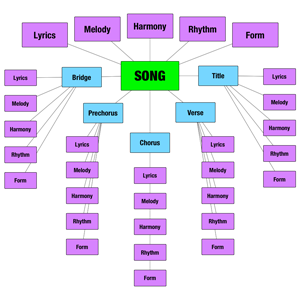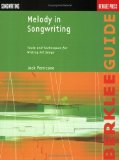-
Melody in Songwriting: Tools and Techniques for Writing Hit Songs
Songwriting Infobox 
Song ModelSongwriting Lyrics - Melody - Harmony - Rhythm - Form Song Form Title - Chorus - Verse - Prechorus - Bridge Melody Infobox Melody Lyric - Melody - Harmony - Rhythm - Form Author: Jack Perricone
Melody in Songwriting: Tools and Techniques for Writing Hit Songs
Part 1 - Melody: Its Components
Chapter 1 - Melody: Some Basics
melody melodic phrase conjunct/disjunct melodic motion writing for the voice the lead sheet guidelines for lead sheet writing writing tip repeat signs writing tip format
Chapter 2 - Pitch
harmonic series the major scale stable and unstable tones tone tendencies tonally open and closed phrases independent melody unstable tones ending phrases writing tip
Chapter 3 - Rhythm
pulse, meter, and rhythm stress symbols summative stress additional considerations in stress assignment masculine/feminine endings beyond simple prosody writing tip
Chapter 4 - Tone Tendencies
immediate resolution, delayed resolution, and no resolution assignment
Chapter 5 - Symmetry/Asymmetry
compositional variables the number of phrases balance vs. symmetry phrase lengths; phrasal balance the rhythm of the phrase matched, inexactly matched, and unmatched phrases correspondence of matched phrases with rhyme outer matching matched rhythms inner rhythmic matching open and closed exercise assignment
Chapter 6 - Melody in Minor
overtone series the minor scales natural minor or Aeolian mode harmonic minor melodic minor
Chapter 7 - Melodic Outline; Melodic Contour
melodic outline melodic step progression embellishing the melodic outline analysis of structural tones and embellishing tones "Cant Take My Eyes Off of You" melodic contour "Because You Loved Me"
Chapter 8 - Controlling the Speed of Your Song
phrasal acceleration/deceleration use of phrasal acceleration/deceleration in songwriting rhythmic acceleration/deceleration
Chapter 9 - Melodic Placement
phrase endings phrase beginnings pickup notes beginning on the weak part of the measure or metric grouping "Love Is You"
Chapter 10 - Building Sections
the order of the phrases building a symmetric section building a balanced but not perfectly symmetric section: open or closed? creating open sections unbalancing a section creating interesting balanced sections fragmentation assignment
Chapter 11 - Developmental Techniques
motive variety within unity developmental technique #1: retain the rhythmic structure, change the pitch sequence use of developmental technique #1 in the compositional process developmental technique #2: varying the phrase structure; extension and truncation developmental techniques assignment
Chapter 12 - Form
song forms the central statement song sections: the verse the refrain the chorus the bridge transitional bridge primary bridge frequently encountered song forms the "standards" song form the introductory verse the chorus the concept of open and closed and its relationship to form verse/refrain verse/chorus bridge sections assignment
Part 2 - Melody-Harmony Relationships
Chapter 13 - Functional Harmony and Harmonic Progression
tonic function triads subdominant function triads dominant function triads stability/instability in harmonic progression functional harmonic progressions
Chapter 14 - A Unified Theory of Melody and Harmony
melodic progression independent and dependent melodies why a unified theory? assignment "Come Rain or Come Shine"
Chapter 15 - Non-Chord Tones and Tensions
non-chord tones "Killing Me Softly" tensions non-chord tones and tensions writing tip
Chapter 16 - Making Harmonic Choices
harmonic choices
Chapter 17 - Melody/Bass Relationships
motion of the bass to the melody chord inversions consonance/dissonance of intervals
Chapter 18 - Harmony in Minor
traditional harmony in minor the harmonic minor scale the melodic minor scale melody/harmony relationships in minor minor to major/major to minor use in form modal interchange
Chapter 19 - Additional Melodic/Harmonic Considerations
harmonic rhythm harmonic cadence use in form harmony's effect on the phrase the harmonic-metric phrase and the melodic rhythmic phrase "The Long and Winding Road"
Chapter 20 - Starting with a Chord Progression
melodic integrity front-heavy melodic phrases; back-heavy melodic phrases assignment
Chapter 21 - Pedal Point, Sus Chords, and Chords without Triads
pedal point assignment sus chords and chords without thirds chords without thirds assignment
Chapter 22 - Blues/Rock
independence of melody and harmony characteristic rock harmony root motion "Addicted to Love" form in blues and early rock emphasis at the beginning (measure 1) emphasis at the subdominant (measure 5) emphasis on the dominant (measure 9) or on the final cadence adding a bridge to the blues other blues-derived forms stylistic considerations assignment
Chapter 23 - Modes
Aeolian mode or natural minor chord progressions in the Aeolian mode strong cadencing progressions root motion writing tip Dorian mode chord progressions in the Dorian mode Mixolydian mode typical Mixolyidan progressions use of pedal point assignment __NOEDITSECTION__
-
Meta

